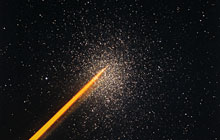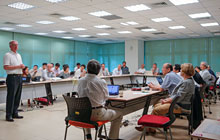Dear Fellow Communicators,
A heads up for those of you who run planetariums or just like to visit them! We are working hard to release the world’s first free fulldome planetarium show for download. From Earth to the Universe is a 30-minute voyage through space and time that conveys, through sparkling sights and sounds, the Universe revealed to us by science. Viewers can revel in the splendour of the various worlds in the Solar System and the scorching Sun. The show takes the audience out to the colourful birth- and resting places of stars, and still further out beyond the Milky Way to the unimaginable immensity of a myriad of galaxies. Along the way, the audience will learn about the history of astronomy, the invention of the telescope, and today’s giant telescope arrays that let us continue to probe ever deeper into the Universe. Stay tuned to benefit from this free show, which will appear in our usual video archive in full optimal 4k resolution for playback.
We are also thrilled to see the ESO Supernova building taking shape, with each day passing bringing changes. You can follow the progress here. If you wish to stay up to date with news and material from the ESO Supernova, you can subscribe to three newsletters:
On the more practical side, since we changed the layout of our website, you should have had a much nicer experience when viewing our images. Some of you however, wanted more features. As a result, we’ve introduced a new function that allows you to sort images and videos either by ranking or by release date. We hope this meets your needs!
Don’t forget that you can also win a trip to Paranal by entering the Photo Nightscape Awards! If you are not a photographer yourself, why not promote this opportunity to your online communities or visitors? They would thank you for that!
On the ESA/Hubble front, we invite you to enjoy our new website! We hope it will make your visit more pleasant and easy to navigate! Since our previous newsletter, we have announced the winners of the Ode To Hubble competition, as well as the places where Hubble 25th Anniversary celebrations took place. Thank you to those of you who joined us to mark this milestone for Hubble!
From the IAU side, clubs and non-profit organisations that are registered with the IAU Directory of World Astronomy can now suggest names for 20 exoworlds. Don’t miss the chance to have your organisation name an exoplanet or its host star! If you promoted or participated in the Mercury crater-naming contest, check out who the winners were.
Let’s reach new heights in astronomy together,
Lars Lindberg Christensen (lars@eso.org)
Head, ESO education and Public Outreach Department (ePOD)

|
8 May 2015: The 4 Laser Guide Star Facility (4LGSF) team have achieved first light with the first of four laser guide star units on Unit Telescope 4 (UT4) of ESO’s Very ...
|
| Read more |

|
4 May 2015: Astronomy has undergone rapid growth in the East Asian region over the past two decades. Very strong astronomy programmes now exist in Japan, China, Korea and Taiwan. Together, these regions ...
|
| Read more |

|
29 April 2015: The 2015 Olivier Chesneau Prize has been awarded to Julien Milli for his impressive achievements in the field of high angular resolution and high-contrast imaging of faint discs around bright ...
|
| Read more |

|
27 April 2015: To enhance their programmes of scientific cooperation with the host country, ESO provides and manages an annual fund for the development of astronomy and technology related disciplines in Chile. The ...
|
| Read more |

|
30 April 2015: ESOcast 74 looks at ESO’s pair of survey telescopes at Paranal: the Visible and Infrared Survey Telescope for Astronomy (VISTA) and the VLT Survey Telescope (VST).
|